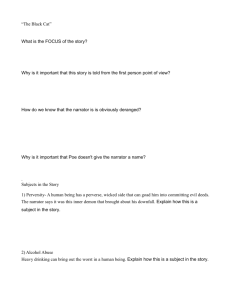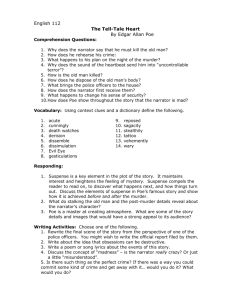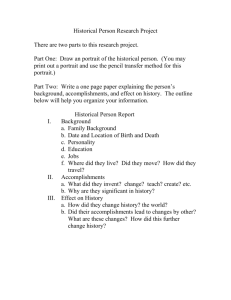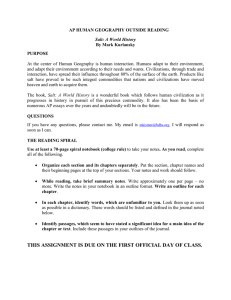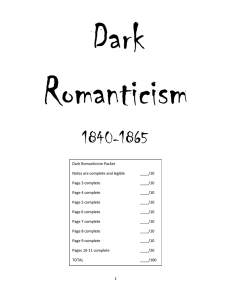Chapter Seven
advertisement
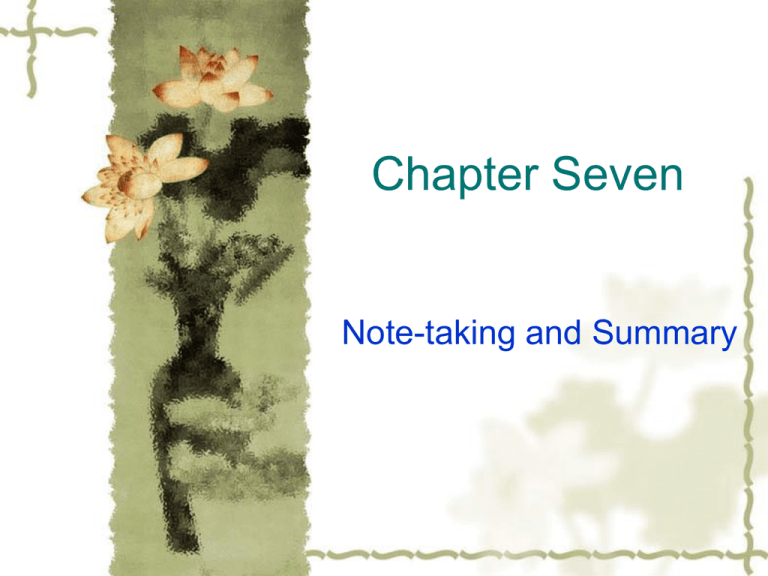
Chapter Seven Note-taking and Summary General introduction “Reading maketh a full man; conference a ready man; writing an exact man.” (Bacon, 1561-1626) Reading and writing are related to each other and usually considered as reciprocal skills in man’s language aptitude. As a student reader, especially an advanced student reader, you may be often expected to read to discuss someone’s argument or to use it as expert evidence for a point you are making in your own argumentative text or to present an opposite point of view that you wish to refute. On this occasion, what you need to do is to take notes or write a summary of the text that you have just read to meet the required demands. Note-taking Taking note is an important tool that reinforces the book your read. It is also a process of critical thinking. Stop at every chapter or even a couple of times every chapter to take down some notes. Write what happens in the book, what you like and what you don’t like, how the writer made his point and what you think inspires you. You would probably disagree with the writer’s opinion; you may think arguments in a book may be based on inaccurate, unreliable or obsolete evidence, and may ignore any evidence against those arguments; you have maybe read newspaper reports that seem biased or lack supporting evidence. In this case, you can write down your opinions in your notebook. This is a good way to improve your reading skills as well as your writing skills. Also, every time you come across a word you like, write down the word, the definition and the sentence it is used in the book. This will help you learn new words for use in your own writing. So effective note taking can help you keep motivated and concentrated while you study, improve your language skills, better your understanding by making you read actively and critically, internalize difficult ideas by putting them into your own words, and organize your ideas in preparation for writing, leading to fuller, better connected arguments in your essays. But while taking notes remember not to take notes all the time and don’t try to take remember everything you read. Of course don’t be concerned about whether anyone else could make sense of your handwriting; you’re the only one who needs to read them. You can try different ways of taking notes. Try lists, colors, bullet points, underlining, highlighting and mind mapping. Experimenting with various methods helps you discover the technique that suits you. How to take notes while reading 1. Read through the chapter you are on, paying attention to what the main focus is. Use a pencil to lightly point out any areas you think might be important. Make sure you do this in pencil, as you will want to erase it later. 2. Draw arrows or underline the heading of the most important points made with pencil as you read through the first time. You will want to pay particular attention to dates, events and names of important people in the area of study. 3. Skim through the chapter a second time with your notebook and pen handy. Write down information that you pointed out in pencil earlier. As you go through the chapter, make sure you erase your pencil marks as you take your notes in your notebook. 4. Organize your notes after you are finished writing down the information you got from the book. It is a good idea to group like things together. For instance if there are dates of events that you need to memorize, organize them in your notebook by date. If it is people and what they did, make a list of names followed by the achievement made. 5. Turn to a blank page in your notebook after you have organized your notes. Write down as much information as you can recall from the notes you took. If you remember some of the facts that you took notes on, you have done a good job taking notes and beginning the process of studying from them. Summary What is a summary? A summary is a brief restatement---in your own words--of the essential thought of a longer composition. It captures all the most important parts of the original but expresses them in a much shorter space. When one writes a summary, one should not interpret or comment. All one has to do is to give the gist of the author’s exact and essential meaning. How to summarize? Reading A. First read the passage through carefully to get the gist of it. If reading it once is not sufficient to give you a clear understanding of it, read it over again. The more you read it, the more familiar to you will be its subject, and what is said about the subject. B. You should now be in a position to decide what parts of the passage are essential and what parts are comparatively unimportant and can be omitted without much loss. C. Jot down in brief notes the main points – the subject, the title, and the details which you consider essential or important. Writing A. A summary should usually be about one-third to one-fourth as long as the original passage. So count the number of words in the passage and divide it by three. You may use fewer words than the number prescribed, but in no case may you exceed the limit. B. The summary should be all in your own words. It must not be a patchwork made up of phrases and sentences quoted from the original passage. C. You should follow the logical order of the original passage, if possible (and desirable). Ideas and facts need not be rearranged. D. The summary should be self-contained, that is, it must convey the message of the original fully and clearly, so that your readers need no reference to the original to understand what its main ideas are. E. Summary writing is an exercise in compression. In writing a summary, you may: -- Omit the details. Only the important points should be included in the summary; all the details that explain the main points can be left out. -- Reduce the examples. Out of five or six examples given in the original passage one or two may be chosen for the summary; the rest are to be omitted. -- Simplify the descriptions. If in the passage there are ten sentences describing a person or an object, it will be enough to keep one or two in the summary. -- Eliminate all repetitions. Sometimes a statement is repeated for emphasis. This is not necessary in a summary. Sometimes an idea is repeated in different words. Such a veiled repetition should also be avoided. -- Compress long sentences and change phrases to words. e.g. 1. His courage in battle might without exaggeration be called lion-like. He was very brave in battle. 2. The account the witness gave of the incident made everyone that heard it laugh. The witness’s story was absurd. 3. John fell into the river and, before help could reach him, he sank. John was drowned in the river. 4. He was hard up for money and was being pressed by his creditor. He was in financial difficulties. You may also make phrases do the work of clauses or sentences. e.g. Beautiful mountains like Mount Tai, Lushan Mountain, and Yellow Mountain, were visited by only a few people in the past. Today, better wages, holidays with pay, new hotels on those mountains, and better train and bus services, have brought them within reach of many who never thought of visiting them ten years ago. Those two sentences may be abridged in this way: Beautiful mountains like Mount Tai, once visited by only a few people, are today accessible to many, thanks to better wages, paid holidays, new hotels and better communication. -- Use general words instead of specific words. e.g. She brought home several Chinese and English novels, a few copied of Time and Newsweek, and some textbooks. She intended to read all of them during the winter vacation. This may be turned into: She brought home a lot of books and magazines to read during the vacation. -- Use the shortest possible transitions. For example, but, then, thus, yet, and for, can be used in place of longer transitions like at the same time, on the other hand, etc. Often the semi-colon can take the place of a transitional word or phrase. -- Put the main points of a dialogue in indirect speech. This is advisable because indirect speech can be made very brief while it is difficult to abridge dialogues. Here is an example: Kate looked at Paul disapprovingly: “You use too much salt on your food, Paul—it’s not at all good for you!” Paul put down his knife and frowned: “Why on earth not! If you didn’t have salt on your food it would taste awful…like eating cardboard or sand…just imagine bread without salt in it, or potatoes or pasta cooked without salt!” Kate was patient. She didn’t want to quarrel with Paul. She wanted to persuade him. She said firmly: “But too much salt is bad for you. It causes high blood pressure and later on, heart-attacks. It also disguises the tastes of food, the real tastes, which are much more subtle than salt, and which we have lost the sensitivity to appreciate any more.” Kate suggested to Paul that he should eat less salt. She thought that eating too much salt would do harm to Paul’s health and that it could reduce the real tastes of food. But Paul disagreed. He said that food without salt would be tasteless. Revision Revise your draft. Compare it carefully with the original to see that you have included all the important points. If it is too long, further compress it by omitting unnecessary words and phrases or by remodeling sentences. Correct all mistakes in spelling, grammar and idiom, and see that it is properly punctuated. Make the language simple and direct. Unit 7 The Oval Portrait Background information to the author Edgar Allan Poe (1809 –1849) was an American author, poet, editor, and literary critic, considered part of the American Romantic Movement. Best known for his tales of mystery and the macabre ([mə'kɑːbr(ə)] adj. strange and horrible or upsetting, usually involving death or injury) , Poe was one of the earliest American practitioners of the short story and is generally considered the inventor of the detective fiction genre. He is further credited with contributing to the emerging genre of science fiction. He was the first well-known American writer to try to earn a living through writing alone, resulting in a financially difficult life and career. LITERARY STYLE AND THEMES GENRES Poe's best known fiction works are Gothic, a genre he followed to appease the public taste. His most recurring themes deal with questions of death, including its physical signs, the effects of decomposition, concerns of premature burial, the reanimation of the dead, and mourning. Many of his works are generally considered part of the dark romanticism genre. Beyond horror, Poe also wrote satires, humor tales, and hoaxes (恶作剧,骗局). LITERARY THEORY Poe‘s writing reflects his literary theories, which he presented in his criticism and also in essays such as “The Poetic Principle”. He disliked didacticism ([daɪ’dæktɪsɪzəm]说教) and allegory, though he believed that meaning in literature should be an undercurrent just beneath the surface. Works with obvious meanings, he wrote, cease to be art. Major Works While-reading activity Read the short story to summarize the main idea. It is a short story in which the narrator ventured into an abondoned chateur one night and was startled and spellbound by the true life-likeness of a portrait of a young lady. Finish the questions in exercises I & II. Analysis The central idea of the story resides in the confusing relationship between art and life. In "The Oval Portrait", art and the addiction to it are ultimately depicted as killers, responsible for the young bride's death. In this context, one can synonymously equate art with death, whereas the relationship between art and life is consequently considered as a rivalry. It takes Poe's theory that poetry as art is the rhythmical creation of beauty, and that the most poetical topic in the world is the death of a beautiful woman (see The Philosophy of Composition). "The Oval Portrait" suggests that the woman's beauty condemns her to death. Poe suggests in the tale that art can reveal the artist's guilt or evil and that the artist feeds on and may even destroy the life he has modeled into art. Post-reading activity Write a brief summary of the short story, “The Oval Portrait”. Plot summary of “The Oval Portrait” The tale begins with an injured narrator and his valet seeking refuge in an abandoned mansion in the Apennines, with no explanation for his wound. He spends his time admiring the works of art decorating the strangely-shaped room and perusing a volume which "purported to criticize and describe" the paintings. He eventually discovers a painting which shocks him with its extreme realism, which he refers to as "absolute life-likeliness of expression". He spends a moment ("for an hour, perhaps", the reader is told) in silent awe of it until he cannot bear to look any more, then consults the book for an explanation. The remainder of the story is a selection from this book discussing how the painting was created — a story within a story. The book explains that the picture was painted by an eccentric artist depicting his young wife, but that he grew obsessed with his painting to the point that he payed no attention to the woman he was painting. When he finishes the painting he is appalled at his own work, and exclaims, "This is indeed Life itself!" Then he turns to see his bride, and discovers that she has died and her spirit was transferred into the lifelike painting. Summary of “The Oval Portrait” The narrator, who is in a "desperately wounded condition", and his valet break into an abandoned castle to spend there the night. Though abandoned, the castle is still lavishly furnished and full of exquisite paintings that capture the narrator’s attention. He is sitting on his bed reading a volume describing the paintings with the candelabrum in his hands and suddenly the light falls into a niche of the room where he discovers another painting he has not yet laid his eyes upon. He is at once startled by the "absolute life-likeliness" of this picture. It is a "mere head and shoulders" and shows a beautiful young girl in an oval frame. He spends a moment in silent awe of it until he cannot bear to look any more, then consults the book for an explanation. There the narrator finds the story of a wild artist who wanted to make a painting of his young and beautiful wife, but became so obsessed with it that he didn't realize his wife falling ill in the process. Eventually, when the picture was finished, he cried out "This is indeed life itself" but, his wife was dead.

